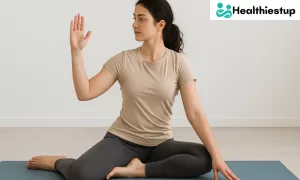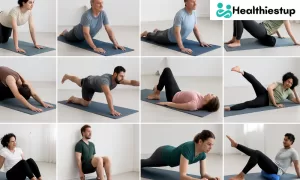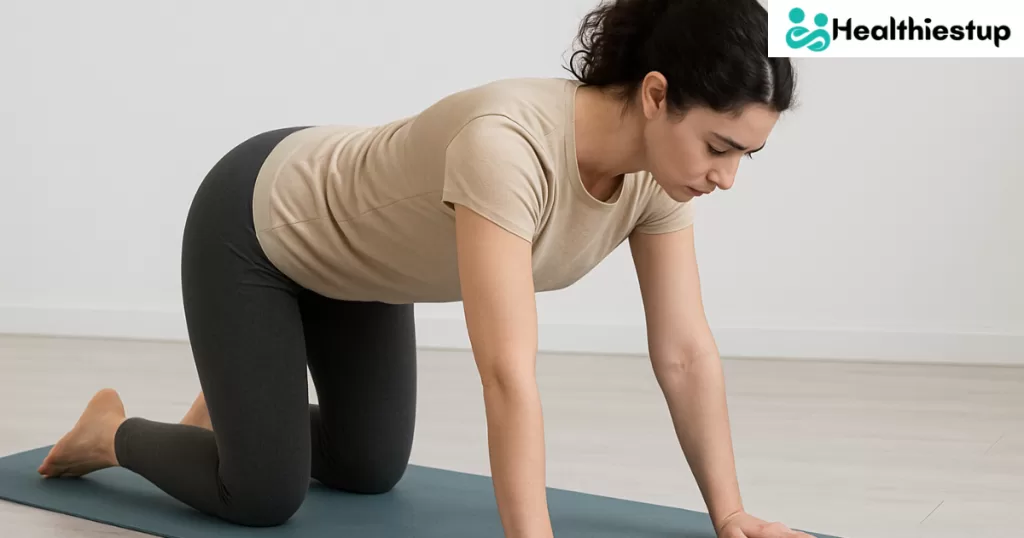Introduction
Back Pain Exercises: Back pain is one of the most common health issues worldwide. Whether it’s from poor posture, long hours at a desk, or heavy lifting, it can creep into your life and slow you down. But here’s the good news simple, consistent back pain exercises can work wonders. No expensive equipment. No gym memberships. Just smart movements to stretch, strengthen, and support your spine.
Back pain exercises are not just about temporary relief. They’re about building long-term resilience. Think of your back like the foundation of a house when it’s strong, everything else functions better. From sitting and standing to walking and lifting, every motion depends on your spine.
The secret? It’s all about targeting the right muscle groups core, glutes, lower back, and even your hamstrings. Done right, these exercises improve posture, increase flexibility, and reduce the risk of future pain. Let’s dive deep into the most effective back pain exercises that you can start today.
Cat-Cow Stretch: Mobilize Your Spine
Back Pain Exercises: The Cat-Cow stretch is a beginner-friendly yoga movement that loosens your spine and improves flexibility. This flow between flexion and extension reduces stiffness and enhances blood flow to your back muscles.
How to do it:
-
Start on all fours with hands under shoulders and knees under hips.
-
Inhale as you arch your back (cow pose), lifting your chest and tailbone.
-
Exhale as you round your spine (cat pose), tucking your chin and tailbone.
-
Repeat slowly for 10-15 reps.
Benefits:
-
Increases spinal flexibility.
-
Reduces stiffness in the lower and upper back.
-
Boosts circulation to spinal discs and muscles.
Consistency is key. Just 5 minutes a day can keep your spine supple and significantly reduce chronic tension. This is especially helpful for those who sit all day or suffer from poor posture.
Child’s Pose: Relax and Release Tension
Back Pain Exercises: Child’s Pose is a calming yoga position that gently stretches your lower back and hips. It’s like giving your spine a warm hug.
How to do it:
-
Kneel on the floor and sit back on your heels.
-
Stretch your arms forward and lower your forehead to the ground.
-
Keep your chest close to your thighs.
-
Hold for 30 seconds to 1 minute while breathing deeply.
Why it works:
-
Eases tension in the lumbar spine.
-
Gently stretches glutes and spinal extensors.
-
Promotes deep relaxation and stress relief.
Use Child’s Pose during breaks at work or after a long day to reset your posture. It’s incredibly effective for decompressing the spine and promoting circulation.
Pelvic Tilts: Strengthen Your Lower Back
Back Pain Exercises: Pelvic tilts are tiny but mighty. They’re great for building strength in your abdominal muscles and lower back—two areas crucial for spinal support.
Steps:
-
Lie on your back with knees bent, feet flat on the floor.
-
Flatten your back against the ground by tilting your pelvis upward.
-
Hold for 5 seconds, then release to the neutral position.
-
Repeat 10-15 times.
Benefits:
-
Strengthens core stabilizers.
-
Reduces stiffness in the lower back.
-
Helps in correcting anterior pelvic tilt, a common postural problem.
Don’t let the simplicity fool you. Pelvic tilts are foundational to any back rehab program. They teach your body how to move in a controlled way, protecting your spine from future injury.
Bird-Dog Exercise: Build Core Stability
Back Pain Exercises: The Bird-Dog is a powerhouse move for building balance, core stability, and back strength. It’s safe, effective, and perfect for beginners.
Instructions:
-
Start on all fours.
-
Extend your right arm forward and left leg back, keeping your hips and shoulders level.
-
Hold for 5 seconds, then return to start.
-
Switch sides. Repeat 10 reps on each side.
Why it’s awesome:
-
Strengthens deep core muscles and lumbar spine.
-
Improves coordination and posture.
-
Reduces risk of future back injuries.
Make sure to keep your movements slow and controlled. It’s not about speed—it’s about activating those deep stabilizer muscles that protect your spine.
Glute Bridges: Strengthen the Hips and Lower Back
Back Pain Exercises: Glute bridges are one of the most underrated exercises for back pain. Why? Because weak glutes often lead to compensations in your lower back, causing pain and tightness. By strengthening your glutes, you offload stress from your spine.
How to perform:
-
Lie on your back with knees bent and feet flat on the floor.
-
Engage your core and lift your hips toward the ceiling until your body forms a straight line from shoulders to knees.
-
Squeeze your glutes at the top and hold for 2–3 seconds.
-
Lower slowly. Repeat 12–15 times.
Perks:
-
Builds posterior chain strength (glutes, hamstrings, lower back).
-
Enhances hip mobility.
-
Reduces spinal compression.
Add a resistance band around your thighs for extra burn. When done correctly and consistently, this move can realign your posture and stabilize your lumbar spine.
Knee-to-Chest Stretch: Loosen Up the Lumbar Area
Back Pain Exercises: This gentle stretch does wonders for a tight lower back and can quickly relieve built-up tension.
Here’s how to do it:
-
Lie on your back with knees bent and feet flat on the floor.
-
Pull one knee gently toward your chest while keeping the other foot on the ground.
-
Hold for 20–30 seconds, then switch legs.
-
Repeat 2–3 rounds per side.
Why it helps:
-
Elongates the lower back muscles.
-
Improves spinal flexibility.
-
Relieves pressure on lumbar discs.
This stretch is perfect first thing in the morning or right before bed. It’s simple but incredibly effective when it comes to improving spinal mobility.
Seated Spinal Twist: Improve Flexibility and Reduce Pain
Back Pain Exercises: Twisting exercises can seem intimidating, but when done mindfully, they are a great way to stretch the entire spine and release tightness, especially from prolonged sitting.

Steps:
-
Sit on the floor with legs extended.
-
Cross your right foot over your left thigh, and place your right hand behind you.
-
Use your left arm to twist your torso toward your right side.
-
Hold for 30 seconds, breathing deeply.
-
Switch sides.
Why it’s amazing:
-
Improves spinal rotation and flexibility.
-
Relieves tension in the mid and lower back.
-
Enhances digestion and posture.
Twists are a natural part of human movement. When done regularly, they help undo the tightness caused by daily stress and screen time.
Wall Sits: Build Endurance in Your Core and Back
Back Pain Exercises: Wall sits aren’t just for athletes—they’re a killer low-impact move to boost endurance in your core and back muscles.
How to do a wall sit:
-
Stand with your back against a wall and feet hip-width apart.
-
Slide down into a seated position with your thighs parallel to the floor.
-
Hold for 20–30 seconds, gradually working up to a minute.
Benefits:
-
Strengthens quads, glutes, and lower back.
-
Builds isometric endurance (the kind you need to maintain posture).
-
Activates your entire posterior chain.
Try holding a light weight or squeezing a ball between your knees for extra intensity. This move not only strengthens your legs and back but also challenges your mental grit.
Cobra Stretch: Open the Chest and Strengthen the Spine
Back Pain Exercises: This yoga-based movement gently stretches your lower back while encouraging spinal extension, which is crucial if you spend most of your day hunched forward.
Instructions:
-
Lie face-down on the floor with palms flat near your shoulders.
-
Press into your hands and lift your chest off the ground, keeping your hips down.
-
Hold the position for 20–30 seconds, then lower slowly.
-
Repeat 5–8 times.
Why you need this:
-
Encourages lumbar spine mobility.
-
Opens the chest and strengthens spinal erectors.
-
Improves posture and reduces forward head syndrome.
Cobra Stretch is especially useful after a long workday at the desk. It resets the spine and combats that curled-forward posture so many of us develop from phone and laptop use.
Standing Hamstring Stretch: Release Lower Back Tension
Back Pain Exercises: Tight hamstrings can tug on your pelvis and lower spine, causing discomfort or even chronic pain. This stretch helps elongate the hamstrings, providing much-needed relief.
Steps:
-
Stand with feet hip-width apart.
-
Bend at the hips and slowly reach toward your toes.
-
Keep your back flat and knees slightly bent.
-
Hold for 30 seconds. Repeat 2–3 times.
Why it works:
-
Lengthens the hamstring muscles.
-
Reduces pull on the lumbar spine.
-
Improves lower body flexibility.
If you can’t touch your toes, no worries—use a yoga strap or towel. With regular practice, you’ll notice increased range of motion and reduced tightness in both your legs and lower back.
Plank Pose: Strengthen Your Core and Protect Your Back
Back Pain Exercises: A strong core is essential for a pain-free back. Planks are one of the best all-in-one exercises that target the entire midsection without straining your spine.
How to do it:
-
Get into a forearm plank position.
-
Keep your body in a straight line from head to heels.
-
Engage your abs, glutes, and thighs.
-
Hold for 20–60 seconds.
Why planks are powerful:
-
Strengthens core stabilizers.
-
Reduces the risk of spinal injury.
-
Supports better posture.
Start with 20 seconds and build up. Don’t forget to breathe! A solid plank can be more effective than hundreds of crunches when it comes to back health.
Lying Spinal Twist: Release Deep Spinal Tension
Back Pain Exercises: This supine twist gently wrings out your spine, helping release deep muscular tension that builds up from prolonged sitting or poor posture.
How to perform:
-
Lie on your back and bring your knees to your chest.
-
Drop both knees to one side while keeping your shoulders flat on the ground.
-
Hold the stretch for 30–60 seconds.
-
Switch sides.
Benefits:
-
Enhances spinal flexibility.
-
Relieves tightness in the mid and lower back.
-
Calms the nervous system.
Twists also improve digestion and lymphatic flow. Incorporate this movement at the end of your stretching routine for a relaxing, restorative finish.
Side-Lying Leg Raises: Strengthen the Hips and Stabilizers
Back Pain Exercises: Your hips are the unsung heroes of a healthy back. When they’re strong and stable, your spine doesn’t have to overwork. Side leg raises target your glute medius, a critical muscle for pelvis and back alignment.
Steps:
-
Lie on your side with legs extended.
-
Lift the top leg to about hip height, keeping it straight.
-
Pause and slowly lower. Repeat 12–15 reps per side.
Why it matters:
-
Strengthens hip abductors and glutes.
-
Supports pelvic alignment.
-
Reduces compensatory back movement.
If you’ve got wobbly hips or back pain when walking or running, this is your go-to exercise. Over time, you’ll notice better balance and reduced strain on your lower back.
Foam Rolling for the Lower Back: Massage and Mobilize
Back Pain Exercises: While not a traditional “exercise,” foam rolling is crucial for loosening tight fascia and increasing blood flow to sore muscles.
How to foam roll:
-
Sit on the floor with a foam roller placed under your lower back.
-
Gently roll up and down a few inches at a time.
-
Focus on the muscles beside your spine—not directly on the spine itself.
-
Roll for 30–60 seconds.
Benefits:
-
Releases muscle knots and adhesions.
-
Improves mobility and flexibility.
-
Boosts recovery after workouts.
It’s like a deep-tissue massage at home. Use it post-workout or at the end of the day to keep your muscles relaxed and mobile.

Conclusion
Back Pain Exercises: Back pain doesn’t have to rule your life. With these 14 carefully chosen back pain exercises, you can take control of your spine health one day at a time. Whether you’re dealing with occasional stiffness or chronic aches, these movements can help stretch, strengthen, and stabilize your back muscles for lasting relief. Remember consistency beats intensity. Five minutes a day is better than one hour once a month. Listen to your body, go slow, and build a routine that fits your lifestyle. Your future self (and spine) will thank you.
FAQs
Q1. How often should I do back pain exercises?
Ideally, aim for at least 3–5 times a week. Even a daily 10-minute routine can show noticeable improvements over time.
Q2. Can I do back pain exercises if I have a herniated disc?
Always consult a doctor first. Some exercises like the Bird-Dog or Cobra may help, but others might aggravate symptoms if not performed correctly.
Q3. Are these exercises suitable for beginners?
Yes! All 14 back pain exercises are beginner-friendly and can be modified to match your fitness level.
Q4. How long does it take to see results?
Many people report relief within a few weeks of consistent practice. Long-term results depend on your commitment and lifestyle adjustments.
Q5. Do I need any equipment for back pain exercises?
Most exercises require just a mat. Optional tools like resistance bands or foam rollers can enhance the effectiveness, but aren’t necessary.



